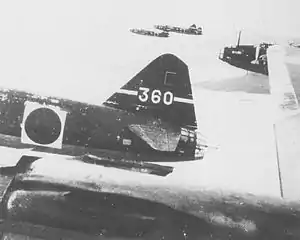Misawa Naval Air Group
The Misawa Naval Air Group (三澤海軍航空隊, Misawa Kaigun Kōkūtai) was an aircraft and airbase garrison unit of the Imperial Japanese Navy (IJN) during the Pacific campaign of World War II. This article handles first generation, second generation, renamed unit the 705th Naval Air Group (第七〇五海軍航空隊, Dai Nana-Maru-Go Kaigun Kōkūtai), and re-organised unit the 706th Attack Squadron (攻撃第七〇六飛行隊, Kōgeki Dai Nana-Maru-Roku Hikōtai) also.
| Misawa Naval Air Group 705th Naval Air Group 706th Attack Squadron | |
|---|---|
 Mitsubishi G4M1 of 705th Naval Air Group in May 1943. | |
| Active | As Misawa Naval Air Group February 10, 1942 – October 31, 1942 September 1, 1944 – June 30, 1945 As 705th Naval Air Group November 1, 1942 – October 1, 1944 |
| Country | |
| Allegiance | Empire of Japan |
| Branch | |
| Type | Naval aviation unit |
| Role | As first generation and 705th Naval Air Group Bomber, torpedo bomber As second generation Trainer |
| Size | 27 aircraft (1 April 1942) |
| Part of | Ōminato Guard District 26th Air Flotilla 25th Air Flotilla 28th Air Flotilla 19th Combined Air Group |
| Garrison/HQ | Kisarazu, Japan Saipan, Marianas Rabaul, New Britain Tinian, Marianas Padang, Sumatra Peleliu, Palau Babeldaob, Palau Misawa, Japan |
| Aircraft flown | G4M Type 1 "Betty" B5N Type 97 "Kate" K5Y Type 93 "Willow" |
| Engagements | World War II |
| Insignia | |
| Identification symbol | As Misawa Naval Air Group ミサ (Misa, used in Japan homeland) H (February–October 1942) As 705th Naval Air Group H (November 1942) T1 (June 1943) 705 (March 1944) |
First generation of the Misawa Naval Air Group and 705th Naval Air Group
Structure
- Higher unit
- Ōminato Guard District (10 February 1942–31 March 1942)
- 26th Air Flotilla (1 April 1942–31 August 1943
- Renamed 705th Naval Air Group on 1 November 1942.
- 25th Air Flotilla (1 September 1943–14 October 1943)
- 28th Air Flotilla (15 October 1943–1 October 1944, dissolved.)
- All land-based attack bombers were independent to the 706th Attack Squadron on 4 March 1944.
- Commanding officers
- Commander/Captain Masao Sugawara (10 February 1942–9 December 1942)
- Captain Yasuo Konishi (10 December 1942–23 May 1944)
- Captain Tarōhachi Shinoda (24 May 1944–1 October 1944, dissolved.)
Second generation of the Misawa Naval Air Group
Reborn as the preparatory flight training unit (Yokaren).
Structure
- Higher unit
- 19th Combined Air Group (1 September 1944–1 March 1945)
- Ōminato Guard District (1 March 1945–30 June 1945, dissolved.)
- Commanding officers
- Commander Takeo Higo (1 September 1944–29 September 1944)
- Captain Shōgo Miyashita (29 September 1944–30 June 1945, dissolved.)
706th Attack Squadron
Structure
- Higher unit
- 755th Naval Air Group (4 March 1944–10 July 1944, dissolved.)
- Squadron leader
- Lieutenant commander Fumio Iwaya (4 March 1944–10 July 1944, dissolved.)
Bibliography
- The Japanese Modern Historical Manuscripts Association, Organizations, structures and personnel affairs of the Imperial Japanese Army & Navy, University of Tokyo Press, Tōkyō, Japan, 1971, ISBN 978-4-13-036009-8.
- Seiki Sakamoto/Hideki Fukukawa, Encyclopedia of organizations of the Imperial Japanese Navy, K.K. Fuyo Shobo Shuppan, Tōkyō, Japan, 2003, ISBN 4-8295-0330-0.
- Bunrin-Dō Co., Ltd., Tōkyō, Japan.
- Model Art, Model Art Co. Ltd., Tōkyō, Japan.
- No. 406, Special issue Camouflage & Markings of Imperial Japanese Navy Bombers in W.W.II, 1993.
- No. 553, Special issue I.J.N. Carrier Attack Bomber, 2000.
- Alumni Association of the 705th Naval Air group, History of the 705th Naval Air Group, Sougo Insatsu Kougei K.K., Tōkyō, Japan, 1985.
- Fumio Iwaya (flight officer of the Misawa/705th Naval Air Group, squadron leader of the 706th Attack Squadron.)
- Navy land-based attack bomber (First volume), Asahi Sonorama, Tōkyō, Japan, 1996, ISBN 4-2571-7305-X.
- Navy land-based attack bomber (Last volume), Asahi Sonorama, Tōkyō, Japan, 1996, ISBN 4-2571-7306-8.
- Senshi Sōsho, Asagumo Simbun, Tōkyō, Japan.
- Vol. 80, Combined Fleet #2, "Until June 1942", 1975.
- Vol. 77, Combined Fleet #3, "Until February 1943", 1974.
- Vol. 39, Combined Fleet #4, "First part of the Third step Operations", 1970.
- Vol. 71, Combined Fleet #5, "Middle part of the Third step Operations", 1974.
- Vol. 45, Combined Fleet #6, "Latter part of the Third step Operations", 1971.
- Vol. 93, Combined Fleet #7, "Final part of the War", 1976.
- Japan Center for Asian Historical Records (http://www.jacar.go.jp/english/index.html), National Archives of Japan, Tōkyō, Japan.
- Reference code: C08030508200, Wartime log book from September 1, 1944 to May 31, 1945, Ominato Naval Guard Station Office (5), Ōminato Guard District, 1945.
- Reference code: C08051771200, Transition table of formation of Imperial Japan Navy Air Units (special establishment) during Pacific War, Japan Demobilization Agency, 1949.
This article is issued from Wikipedia. The text is licensed under Creative Commons - Attribution - Sharealike. Additional terms may apply for the media files.